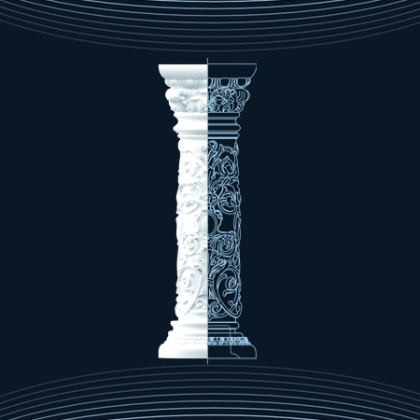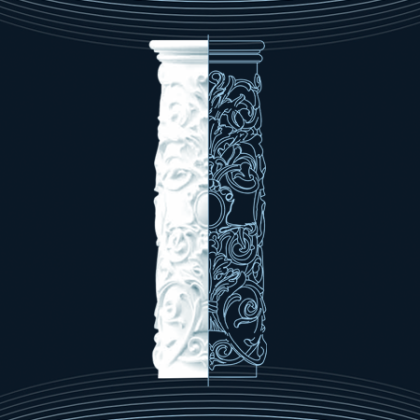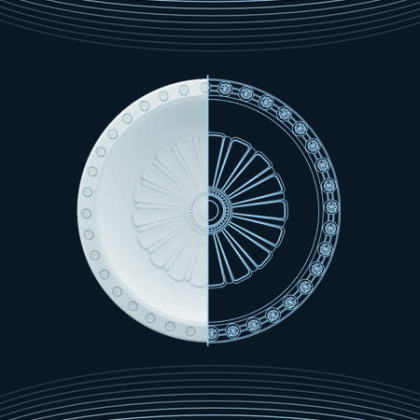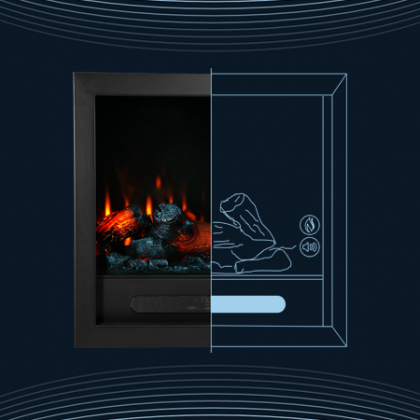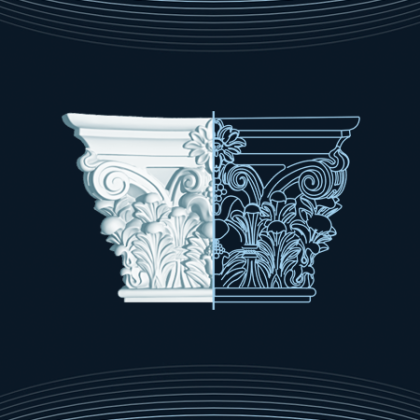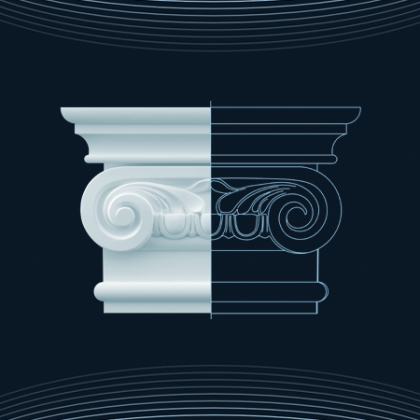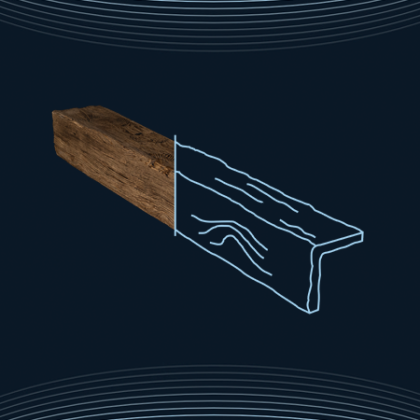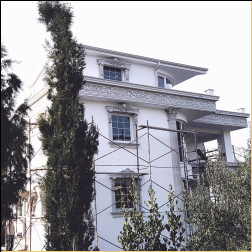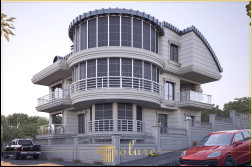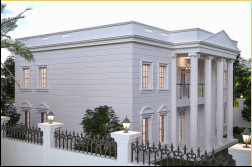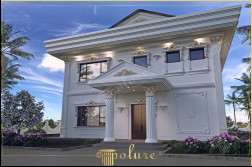
Polyurethane villa exterior decoration models refer to designs and styles for decorating the outside of villas using polyurethane materials.
Polyurethane, often referred to as PU, is a versatile polymer that has gained significant popularity in the field of exterior decoration, especially for villas and luxury homes. Its ability to mimic the appearance of more traditional materials like wood, stone, and plaster, while offering superior durability and ease of maintenance, makes it an attractive option for homeowners and architects alike. Polyurethane offers several advantages for exterior decoration. Firstly, it is highly resistant to weathering, moisture, and temperature fluctuations, ensuring that the decorative elements retain their appearance over time. Secondly, it is lightweight, which makes it easier to install and reduces the load on structural elements of the building. Lastly, it allows for a high degree of customization in terms of shapes, sizes, and finishes, enabling architects and designers to realize their creative visions without constraints. Polyurethane villa exterior decoration models offer a blend of aesthetic appeal, durability, and ease of installation that is hard to match with traditional materials. Whether you are building a new villa or renovating an existing one, incorporating polyurethane decorative elements can significantly enhance the property's exterior appeal and value.Polyurethane Villa Exterior Decoration Models
Why Choose Polyurethane for Villa Exteriors?
Popular Polyurethane Decoration Models for Villas
Conclusion
The significance of Villa Exterior Decoration Models in history.
The exterior decoration of villas has played a pivotal role in architectural history, reflecting the cultural, social, and economic contexts of their times. From ancient Roman villas to modern luxury homes, the evolution of exterior decoration models showcases the changing tastes, technologies, and materials available to architects and homeowners. In ancient Rome, villas were symbols of wealth and status, and their exterior decorations were designed to impress. Mosaics, frescoes, and elaborate gardens were common, showcasing the owner's taste and the skills of the craftsmen. These elements not only beautified the villas but also reflected the Roman appreciation for art, nature, and the gods. The Renaissance era saw a revival of classical ideals in villa design, with a focus on symmetry, proportion, and harmony. Exterior decorations became more refined, with an emphasis on architectural elements such as columns, pediments, and balustrades. Gardens also became more structured, mirroring the architectural balance of the villas themselves. In the modern era, villa exterior decoration has embraced a wide range of styles, from the ornate embellishments of the Victorian era to the sleek lines of contemporary design. Advances in materials and technology have expanded the possibilities for exterior decoration, allowing for greater creativity and personal expression. Today's villas often blend traditional elements with modern design, creating unique and personalized spaces that reflect the owner's tastes and lifestyle. The history of villa exterior decoration models is a testament to the enduring importance of beauty and aesthetics in our living spaces. As we continue to innovate and evolve, the decoration of villa exteriors will undoubtedly continue to reflect our changing world, while also paying homage to the rich architectural traditions of the past.The Historical Significance of Villa Exterior Decoration Models
Ancient Times
The Renaissance
The Modern Era
Conclusion
Polyurethane Villa Exterior Decoration Models characteristics.
Polyurethane, often known as PU, is increasingly becoming a popular choice for villa exterior decorations due to its durability, flexibility, and aesthetic appeal. This synthetic material offers numerous advantages for exterior design, making it an ideal choice for homeowners looking to enhance the curb appeal of their villas. Below, we explore some key properties of polyurethane villa exterior decoration models. One of the standout features of polyurethane is its exceptional durability. It is resistant to weather changes, moisture, and even UV rays, ensuring that the exterior decorations remain in pristine condition for years. This makes polyurethane an excellent investment for those seeking long-lasting beauty for their villa exteriors. Polyurethane is highly flexible, which allows for the creation of intricate designs and patterns. Whether you are looking for classic cornices, elegant columns, or detailed moldings, polyurethane can be molded into various shapes and sizes to match your aesthetic preferences. This flexibility opens up a world of possibilities for customizing the exterior of your villa. The aesthetic appeal of polyurethane decoration models is undeniable. With the ability to mimic the look and feel of more traditional materials like wood and stone, polyurethane offers a cost-effective alternative without compromising on style. Moreover, it can be painted in any color, allowing homeowners to personalize their villa exteriors to suit their tastes. Another advantage of choosing polyurethane for villa exterior decorations is the ease of installation and maintenance. Being lightweight, it can be easily installed without the need for heavy machinery or specialized tools. Additionally, polyurethane is easy to clean and requires minimal maintenance, making it a convenient choice for busy homeowners. Polyurethane also contributes to energy efficiency. Its insulating properties can help reduce heating and cooling costs, making your villa more environmentally friendly and cost-effective in the long run. This feature is particularly appealing for those looking to combine aesthetic enhancements with practical benefits. In conclusion, polyurethane villa exterior decoration models offer a blend of durability, flexibility, aesthetic appeal, and practical benefits. They provide a versatile and cost-effective solution for those looking to elevate the exterior appearance of their villas while ensuring long-term performance and ease of maintenance.Polyurethane Villa Exterior Decoration Models
Durability
Flexibility
Aesthetic Appeal
Easy Installation and Maintenance
Energy Efficiency
Are the applications of polyurethane villa exterior decoration models distinct?
Polyurethane is a versatile material widely used in the construction and decoration industry, particularly for villa exterior decorations. Its flexibility, durability, and resistance to weather conditions make it an ideal choice for enhancing the aesthetic appeal of buildings. The usage areas of polyurethane villa exterior decoration models are diverse, catering to different architectural styles and personal preferences. Polyurethane decoration models can be applied in various parts of a villa's exterior, including: Choosing polyurethane for villa exterior decoration comes with several benefits: In conclusion, polyurethane villa exterior decoration models offer a practical and aesthetically pleasing solution for enhancing the appearance and functionality of villa exteriors. Their diverse application areas, coupled with the material's beneficial properties, make them a popular choice among homeowners and architects alike.Polyurethane Villa Exterior Decoration Models
Different Usage Areas
Benefits of Using Polyurethane
Polyurethane Villa Exterior Decoration Models
When it comes to enhancing the exterior of a villa, selecting the right decoration models is crucial. Polyurethane, with its versatility and durability, has emerged as a popular choice among homeowners and architects alike. This article explores various polyurethane villa exterior decoration models that can transform the facade of your home.
Polyurethane is renowned for its resistance to weather conditions, including UV rays, rain, and temperature fluctuations. Its lightweight nature makes it easy to install, and it can be molded into a vast array of shapes and designs, making it ideal for exterior decorations. Moreover, polyurethane requires minimal maintenance and can mimic the appearance of more expensive materials like wood and stone.
The flexibility of polyurethane allows for a multitude of decoration models. Here are some popular choices:
One of the greatest advantages of polyurethane decorations is their customizability. Whether you have a specific design in mind or need assistance in choosing the right elements, manufacturers and designers can help bring your vision to life. Installation is straightforward, and many polyurethane products come with mounting hardware, making it a feasible project for skilled DIYers or professional contractors.
Polyurethane villa exterior decoration models offer a perfect blend of beauty, durability, and ease of installation. By choosing polyurethane for your exterior decorations, you can achieve a sophisticated look that will stand the test of time. Whether you prefer a classic or contemporary design, there’s a polyurethane decoration model that can meet your needs and exceed your expectations.
Polyurethane Villa Exterior Decoration Models
Advantages of Polyurethane
Popular Decoration Models
Customization and Installation
Conclusion
Yes, polyurethane models for villa exterior decoration can be used on outside walls.
When it comes to enhancing the aesthetic appeal of villa exteriors, homeowners and designers are always on the lookout for innovative and durable materials. Polyurethane (PU) villa exterior decoration models have emerged as a popular choice due to their versatility, durability, and ease of maintenance. This article explores the feasibility and benefits of using polyurethane decoration models on exterior walls. Polyurethane is a type of polymer that is known for its flexibility, resilience, and resistance to weather conditions. These properties make it an ideal material for outdoor applications, including villa exterior decorations. Polyurethane models can mimic the look of more traditional materials like wood, stone, and concrete, but with added benefits. While polyurethane offers numerous advantages, there are a few considerations to keep in mind. It is important to ensure that the polyurethane models are specifically designed for outdoor use and have been treated to resist UV rays, which can cause fading over time. Additionally, proper installation is crucial to prevent moisture from getting trapped behind the models, which could lead to mold or mildew. Polyurethane villa exterior decoration models offer a practical and aesthetically pleasing solution for exterior walls. With their durability, ease of maintenance, and design flexibility, they can significantly enhance the appearance of any villa. By selecting high-quality, UV-resistant models and ensuring proper installation, homeowners can enjoy the benefits of polyurethane decorations for years to come.Can Polyurethane Villa Exterior Decoration Models Be Used on Exterior Walls?
What is Polyurethane?
Benefits of Using Polyurethane for Exterior Walls
Considerations for Using Polyurethane on Exterior Walls
Conclusion
Can models for decorating the outside of villas made from polyurethane be painted?
When it comes to renovating or refreshing the exterior of a villa, homeowners often explore various materials and techniques to enhance the aesthetic appeal of their property. One such material that has gained popularity for exterior decoration is polyurethane. Known for its durability, lightweight, and easy installation, polyurethane exterior decoration models can significantly elevate the appearance of a villa. However, a common question that arises is whether these polyurethane decorations can be painted. The answer is yes. Polyurethane villa exterior decoration models can indeed be painted, which allows for a high degree of customization to match any exterior design theme. Painting polyurethane is not only possible but also relatively straightforward, provided that the correct preparation and materials are used. Before painting, it is crucial to ensure that the surface of the polyurethane decoration is clean, dry, and free from any grease or dust. A light sanding may also be necessary to create a surface that allows the paint to adhere better. Once prepared, a primer designed for use on polyurethane should be applied. This step is essential for achieving a uniform and durable finish. After the primer has fully dried, the polyurethane can be painted with the color of choice. For the best results, using exterior-grade paint that is suitable for use on plastic materials is recommended. Acrylic latex paint is often a good choice due to its durability and ease of application. Depending on the desired finish, multiple coats may be necessary, with sufficient drying time between each coat. Painting polyurethane villa exterior decoration models offers several benefits. It not only allows homeowners to match the decorations to the villa's overall color scheme but also provides an additional layer of protection against the elements. With the right type of paint, the polyurethane decorations can withstand UV rays, moisture, and temperature fluctuations, ensuring that they remain vibrant and intact for years to come. In conclusion, painting polyurethane villa exterior decoration models is a feasible and effective way to customize and protect these decorative elements. By following the proper preparation and painting process, homeowners can achieve a professional-looking finish that enhances the beauty and value of their property.Painting Polyurethane Villa Exterior Decoration Models
Can Polyurethane Be Painted?
Preparation and Painting Process
Benefits of Painting Polyurethane Decorations
Conclusion
To apply polyurethane for decorating the exterior of a villa, follow these steps: 1. Prepare the surface by cleaning and sanding. 2. Apply a primer if needed. 3. Use a brush, roller, or sprayer to apply the polyurethane. 4. Allow it to dry completely. 5. Apply additional coats if necessary, sanding lightly between coats.
Decorating the exterior of a villa not only enhances its aesthetic appeal but also protects it from environmental elements. Polyurethane is a popular choice for exterior decoration due to its durability, versatility, and excellent finish. Here is a guide on how to apply polyurethane for villa exterior decoration. Applying polyurethane to the exterior of a villa can significantly enhance its appearance and protect it from the elements. By following these steps, you can achieve a durable and high-quality finish that will last for years to come.Applying Polyurethane for Villa Exterior Decoration
Materials Needed
Steps to Apply Polyurethane
Conclusion
Polyurethane villa exterior decoration models are durable and resistant to weather, while styrofoam models are lightweight and easier to install but less durable.
When it comes to enhancing the aesthetic appeal of a villa's exterior, choosing the right material for decoration models is crucial. Two popular materials in the market are polyurethane and styrofoam. Although both can be used for decorative purposes, they have distinct characteristics that set them apart. Polyurethane is known for its exceptional durability and strength. It is resistant to weather changes, moisture, and even pests, making it an ideal choice for exterior decorations that require longevity. Styrofoam, on the other hand, is less durable compared to polyurethane. It is more susceptible to physical damage and degradation over time, especially when exposed to harsh weather conditions. Styrofoam has excellent insulation properties, making it a popular choice for projects where thermal insulation is a priority. While polyurethane also has good insulation capabilities, styrofoam outperforms it in this aspect. This makes styrofoam a preferred material for certain applications where maintaining temperature is crucial. Styrofoam is significantly lighter than polyurethane, which makes it easier to handle and install. This lightweight nature can be advantageous in projects where reducing structural load is important. However, polyurethane's density contributes to its durability and strength, which might be more desirable for long-term applications. Both materials have environmental considerations. Polyurethane, being more durable, tends to have a longer lifespan, potentially reducing the need for frequent replacements. Styrofoam, while less durable, is often criticized for its environmental impact, particularly concerning its biodegradability and the challenges associated with recycling it. Cost is another factor that can influence the choice between polyurethane and styrofoam. Generally, styrofoam is less expensive than polyurethane, making it an attractive option for budget-conscious projects. However, the long-term durability of polyurethane might offer better value over time, despite its higher initial cost. In conclusion, both polyurethane and styrofoam have their advantages and disadvantages for use in villa exterior decoration models. The choice between them should be based on the specific requirements of the project, including considerations of durability, insulation properties, weight, environmental impact, and cost.Difference Between Polyurethane and Styrofoam Villa Exterior Decoration Models
Durability and Strength
Insulation Properties
Weight and Ease of Installation
Environmental Impact
Cost
The difference lies in the materials used for decorating the exteriors of villas. Polyurethane models use a synthetic material, while plaster models use a mixture of water, gypsum, and sometimes fibers for reinforcement.
When it comes to villa exterior decoration, two popular materials often come into consideration: polyurethane and plaster. Both materials offer distinct characteristics and benefits, making them suitable for different types of exterior decoration projects. Understanding the differences between these materials can help homeowners and designers make informed decisions for their villa exteriors. Polyurethane is a type of plastic that is highly versatile and durable. It is resistant to weather changes, moisture, and insects, making it an ideal choice for exterior decorations that require longevity and minimal maintenance. Polyurethane decorations can mimic the appearance of more traditional materials, such as wood or stone, without succumbing to their typical weaknesses. Plaster, on the other hand, is a mixture of water, gypsum, or cement, which is applied wet and hardens to a very dense solid. It is a traditional material that has been used for centuries in building and decoration. Plaster decorations offer a classic and elegant look, but they are more susceptible to weathering, moisture, and physical damage compared to polyurethane. Polyurethane decorations are generally lighter and easier to install than plaster. They can be easily cut and adjusted on-site, allowing for greater flexibility in design and installation. Additionally, polyurethane can be molded into a wide variety of shapes and designs, offering more options for customization. Plaster requires skilled craftsmanship for installation, as it needs to be mixed, applied, and shaped before it hardens. This process allows for unique, custom shapes and textures but can be more time-consuming and labor-intensive. Plaster decorations are heavier and require a solid support structure. From an environmental perspective, plaster is often considered more sustainable than polyurethane. Plaster is made from natural materials and is biodegradable, whereas polyurethane is a synthetic material derived from petroleum products. However, the durability and low maintenance of polyurethane decorations can contribute to less frequent replacements and, consequently, a reduced environmental impact over time. Choosing between polyurethane and plaster for villa exterior decorations depends on several factors, including durability, installation, customization, and environmental impact. Polyurethane offers a modern, versatile, and low-maintenance option, while plaster provides a classic, elegant, and customizable choice. Homeowners and designers should consider the specific needs and preferences of their project to make the best decision.Difference Between Polyurethane and Plaster Villa Exterior Decoration Models
Material Composition and Durability
Installation and Customization
Environmental Considerations
Conclusion
Polyurethane precast and GRC (Glassfibre Reinforced Concrete) precast are both materials used in construction, but they are different in composition and properties. Polyurethane precast is made from a type of plastic that is strong and flexible. It is lightweight and can be used to make various decorative shapes and finishes. It's often used for moldings, frames, and panels. GRC precast, on the other hand, is a type of concrete that is reinforced with glass fibers. This makes it much stronger and more durable than regular concrete, but still lighter. GRC is used for a wide range of applications, including cladding panels, architectural features, and landscaping elements. In summary, polyurethane precast is a lightweight, flexible plastic product, while GRC precast is a strong, durable, and lightweight concrete product reinforced with glass fibers.
Understanding the distinction between polyurethane precast and GRC (Glassfibre Reinforced Concrete) precast is essential for architects, builders, and developers who aim to choose the right material for their construction projects. Both materials offer unique benefits and have specific applications in the construction industry. Polyurethane precast is a type of building material made from high-density polyurethane foam. It is known for its lightweight, durability, and flexibility. Polyurethane precast products are often used for decorative architectural elements such as moldings, trim, and facade details. They are easy to install, require minimal maintenance, and can be designed to mimic the appearance of more traditional materials such as wood, stone, or concrete. GRC precast, or Glassfibre Reinforced Concrete, combines cement, fine aggregate, water, chemical admixtures, and glass fibers. It is renowned for its strength, durability, and versatility. GRC precast is significantly lighter than traditional concrete, making it easier to handle and install. It is commonly used for a wide range of applications, including cladding panels, architectural elements, and landscaping products. In conclusion, the choice between polyurethane precast and GRC precast depends on the specific requirements of the project, including the intended application, budget, and desired aesthetic. Both materials offer distinct advantages, making them valuable options in the construction industry.Difference Between Polyurethane Precast and GRC Precast
Polyurethane Precast
GRC Precast
Key Differences
Prices of polyurethane villa exterior decoration models.
When it comes to enhancing the exterior appeal of villas, polyurethane decoration models stand out as a popular choice among homeowners. Known for their durability, versatility, and aesthetic appeal, polyurethane decorations can transform the exterior of any villa into a stunning masterpiece. This article explores various polyurethane villa exterior decoration models and their prices to help you make an informed decision. Polyurethane is a highly versatile material that offers numerous benefits for exterior decorations. It is lightweight, making it easy to install and handle. Despite its lightness, polyurethane is extremely durable and resistant to weather conditions, ensuring that your decorations remain pristine for years. Its flexibility allows for the creation of intricate designs, from classic motifs to modern patterns, catering to a wide range of architectural styles. Investing in polyurethane villa exterior decorations is an excellent way to enhance the beauty and value of your property. With a variety of models and prices, you can choose the perfect decorations to match your villa's architectural style and personal taste. Whether you prefer the timeless elegance of classic designs or the sleek appeal of modern decor, polyurethane decorations offer a durable, versatile, and aesthetically pleasing solution.Polyurethane Villa Exterior Decoration Models and Prices
Benefits of Polyurethane Decorations
Popular Polyurethane Villa Exterior Decoration Models
Conclusion
Information Gallery
List of detailed descriptions of images in the image gallery.
 English
English
 Romanian
Romanian





